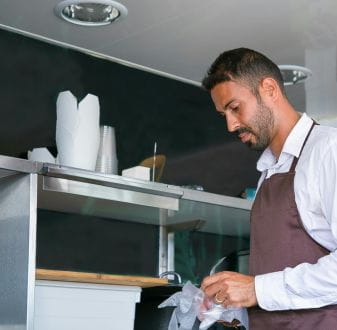When international travel ground to a halt because of COVID-19, it was a wake-up call reminding us just how big a role tourism plays in supporting the global economy.
In 2019, the hospitality and tourism industry contributed huge AUD$12.4 trillion (US$8.9 trillion) to the world’s GDP, employing an average of one in ten people globally.
According to January 2021 estimates, the pandemic has so-far cost the global tourism industry around AUD$1.3 trillion (US$935 billion) in total. Of course, every country and region has experienced different levels of impact, while some are far more reliant on tourism for survival than others.
It's clear that small-island and developing nations have suffered the most. Some of these, such as Macao and Aruba, lost almost half of their entire national GDP when they lost tourism.
In Australia, operators and employees have been waiting for two years for borders to reopen, international tourism to resume and business to pick up again.
Tourism is back in Australia in 2022
With international tourism for vaccinated people now finally set to resume in February 2022, hospitality and tourism industry professionals across Australia are breathing a sigh of relief.
The resumption of tourism is good news for the thousands of people employed directly in hospitality and tourism, but it’s also great news for the whole country. Tourism has always been a major economy, but it will form an even more crucial part of Australia’s post-pandemic economic recovery over the coming years.
This article will take a detailed look at these six important reasons why Tourism:
- is a strong growth industry that provides a lot of employment
- supports regional areas and secondary industries through spending
- is central to the agricultural sector
- provides seasonal hospitality workers
- along with the conservation of natural assets are intrinsically linked in a low carbon future
- will play a central role in long-term sustainable development goals
Tourism is a huge and growing industry that provides a lot of direct employment
The travel and tourism industry is one of the largest industries in Australia, contributing over AU$50 billion to GDP in recent years. It is also the country’s largest services export industry, accounting for around 10% of total exports.
Before the pandemic approximately 748,200 people were employed directly within the tourism sector, or roughly one in thirteen working Australians - a figure which has almost doubled over the last decade. There has been a huge recent growth in Australian tourism from China, India and other countries nearby, that have growing middle-classes.
In the financial year 2019, the GDP from tourism increased by 6.6%, representing an ongoing trend of year on yeartourism growth. For comparison, the mining sector in Australia employs approximately just 50,000 people in total and has a much slower job growth rate of 0.4% over the next five years.
Tourism supports a lot of employers, and it’s ongoing growth is essential to keep those businesses flourishing.
Growth across the tourism industry for the 2020 financial year plunged from +6.6% down to -17.6 percent, as a direct result of the pandemic. Not surprisingly, this has translated directly into job losses over the past two years.
In the year to March quarter 2021, tourism filled jobs fell by 5.1% to 662,700, according to figures from the Australian Bureau of Statistics. This number is a slight increase from 2020, when there were 611,700 tourism jobs at the end of June 2020; an 18% drop compared to the same time the year before.
Between mid-March and early May 2020, ABS payroll data additionally shows that 7% of jobs were shed nationally, while for the accommodation and hospitality sector there were 27% fewer jobs. Travel agencies and tour operators who book trips for outbound tourists also reported revenue losses on the previous year of 85-100% across the sector, due to the travel ban.
With so many jobs and livelihoods at stake, it’s clear that tourism has a major role in directly employing Australians in the post-pandemic recovery period.
Tourism’s impact on secondary industries and regional communities via spending
In addition to direct employment, tourism also has a positive flow-on impact on other industries such as agricultural and cultural industries, and on remote or regional communities.
Perhaps most obviously, hospitality and tourism are intrinsically connected, with roughly 30 cents of every international tourist dollar being spent on food and accommodation services in Australia. Roughly 44 cents of every tourist dollar goes to regional areas, making it an important mainstay for rural communities.
Of course, tourists don’t only eat, drink and stay in hotels. They are also increasingly interested in cultural activities, and their spending supports local artisans and creative industries.
The number of international tourists who are participating in indigenous cultural activities in Australia, for example, grew by over 40% between 2013 and 2018. In 2017, 47% of those visitors saw an art, craft or cultural display, 29% attended a dance or theatre performance and 14% purchased crafts, art or souvenirs to take home.
Agricultural businesses are reliant on tourist workers
In a normal year, backpackers make up 80% of Australia’s harvest workforce. With International Working Holidaymakers (IWHs) banned from entering the country to work as farm labourers in 2020, the impact on the agricultural sector has been disastrous.
Without enough harvest labourers, farmers have reportedly had to leave fruit rotting in the fields, with significant losses. According to statistics from the National Lost Crop Register, between December and January 2021, fifty-five registered growers lost a total of AU$38 million as a direct result of labour shortages.
In response, the Federal Government created a new AgVisa for backpacker-labourers in October 2021; however, it’s yet to have any effect in enticing these much needed workers back to Australia. The backpacker-harvester shortage has brought international media attention to bad working conditions on some Australian farms, which may have a negative impact on uptake of AgVisas.
Hospitality businesses can’t find staff because of border closures
Two significant sources of labour in the hospitality industry in Australia are typically backpackers and cooks who come over on skilled migration visas. Restaurants, hotels, bars and cafes around the country are currently experiencing a massive shortage of staff due to the ongoing travel ban.
Without access to these sources of labour businesses have been struggling to stay open, running on less than half or even a quarter their usual number of staff.
Many hospitality businesses were hoping for a strong 2021/2022 summer season to fuel their recovery after the pandemic. Businesses in rural and regional areas, many of which rely on seasonal tourism, have been particularly looking forward to this season's post-lockdown reopening. However, without enough staff, some report having to cut opening hours in order to get by, losing out on a much-needed boost to profits.
Tourism is now officially resuming in 2022, bringing with it new potential hospitality workers, but it will take time before this translates to a direct ease of staffing pressure.
Untouched nature is crucial to the future of Australian destination marketing
Animals and the ecosystems in which they live are now a major reason for travelling, across 20 - 40% of the global tourism industry.
Australia’s isolation, unique flora and fauna, natural assets and low population have made it a popular destination for international visitors who want to enjoy nature away from the crowds.
That desire for natural purity and sparse population has become even more popular among tourists following the pandemic. In a 2021 survey across 13 countries and involving 20,000 respondents, Australia, New Zealand and Canada came in as the top destinations that tourists would like to visit.
The reasons given are because they are less populated, nature-based destinations with clean environments.
A 2021 study commissioned by Booking.com of 20,000 people across 28 countries similarly found that after a year of pandemic, the top traveller priorities are now: safety, in regards to COVID-19, and an eco-conscious mindset.
The report also found that 62% expect more sustainable travel options, and that travellers will visit alternative destinations in a bid to avoid travelling during peak season and overcrowding.
The consensus among similar studies is that the coronavirus has inspired people to not just be committed to protecting themselves, but also the places they visit. Changes in consumer feedback and behaviour indicate growing a commitment to low-impact travel. Sustainability will need to form a key cornerstone of tourism in Australia, in future.
Sustainable tourism an essential pillar of economic development in a low-carbon future
In Australia, the unique natural assets which we market as pristine, untouched tourist destinations are also uniquely vulnerable to environmental damage.
Approximately 69,000 jobs are supported through tourism at the Great Barrier Reef in Queensland, for example, more than all the coal jobs across the whole of Australia. However, the reef is being damaged by climate change.
At the risk of losing these invaluable natural assets, economic recovery in the aftermath of COVID-19 cannot come at the expense of the environment.
In his launch of the UN Policy Brief on COVID-19 and Transforming Tourism in 2020, UN Secretary General António Guterres highlighted the important role tourism plays in the world:
“Tourism is one of the world’s most important economic sectors. Tourism is also a key pillar for the conservation of natural and cultural heritage...It is imperative that we rebuild the tourism sector.
But it must be in a way that is safe, equitable and climate friendly. Transport-related greenhouse gas emissions could rebound sharply if recovery is not aligned with climate goals.”
The UN outlines a sustainable, post-pandemic recovery plan for the global tourism industry, a useful blueprint for Australia’s own recovery of the tourism sector.
Governments, including the UK, USA and China, are also finally committing to legally binding net-zero emissions targets by 2050 and consumer spending patterns have changed. It’s clear which way economic development goals are turning, and that Australia needs to keep up.
Sustainable tourism has a significant role to play in the economy, when Australia decides to move away from fossil fuels and towards low-carbon economic development.
Unlike finite resources, such as coal, Australia’s unique natural destinations, cultural attractions and internationally renowned cities are sustainable assets that - if looked after - will continue to support economic activity for generations to come.





